Covid19: The hotel industry then and now
26 min read

26 min read

by Aleksandra Gagic
In our very first article in the Covid19 series, we talked about the aviation, its history, and the scale of setbacks caused by the unprecedented crisis during the Covid19 pandemic. As a logical continuance, in this next article, we will discuss the hotel industry. In order to understand the dynamics of this industry as one of the core parts of tourism, we’ll start from the birth of inns and their development over the years. We will go over the actual numbers concerning revenue losses and jobs that were cut (or are at risk of being cut), just to be able to grasp the actual impact on the lives that are dependent on this industry. Finally, we will talk about what the future may hold for the hotel industry and offer advice and mitigation strategies for hoteliers to help them stay afloat while the consequences of the pandemic and its eventual aftertaste last.
A home away from home – that’s what hotels mean to us nowadays. Hotels today come with a long list of services and some of them really go out of their way to ensure the guests are having the best possible experience during their stay. Before the Covid19, the hotel industry was in its peak growth thanks to a plethora of reasons – we’ll go over the most important ones in a bit – in order to try and fully understand what led to the expansion of hospitality and its rapid growth. Before we jump straight over to that part of the story, let us offer a quick, yet resourceful, history of the hotel industry which will paint a clear picture of where it all began.
The story of hotels is an important part of the history of civilization. If we really think about it, places offering hospitality to guests have been there since early biblical times. In fact, the ancient Greeks were the ones who developed thermal baths in rural areas. These baths were built to be areas where guests could rest and recuperate. Later on, the Romans turned to building mansions in order to provide comfortable accommodation for travelers on government business. Additionally, the Romans were the ones who first developed thermal baths in Switzerland, England, and the Middle East and this spurred the development of caravanserais providing a place for caravans and people who are in desperate need of recovery after a day-long journey.

In the Middle Ages, monasteries and abbeys were the first to offer travelers with the refuge on a consistent basis. So, the very first inns and hospices were built by the Religious orders trying to cater to those that were on the move. Early on, the inns were multiplying but they were still offering shelter only, without any meals included. A nice addition was having staging posts that provided shelter for horses, which then led to a higher number of crusaders and pilgrims on their way to the Holy Land. One of the most famous inns is “Hotel Drei Könige” in Basel, occasionally cited as Switzerland’s oldest hotel, located on the left bank of the Rhine. Prior to the railway, the Rhine was the most important trade route in western Europe. The “Hotel Drei Könige” establishment has been identified in 1255 as “Domus zem blumen in vico crucis” (The House of Flowers across the street). It has been demolished after the 1356 earthquake and the first record of a hotel on this same site, with its modern name, dates from 1681. At that time, it has been identified as a spot where merchants would frequently lodge.

Around that same time, in 1200, stations for couriers and staging posts were getting set up in China and Mongolia and inns were being opened across Europe, such as “l’ Auberge Cour Saint Georges” in Gent, Belgium and “The Angel Inn” in Lincolnshire, England. Therefore, a conclusion could be drawn that these were the times when people all over the world were getting the first taste of hospitality.
As in all industries, there is an ever growing development, but there are also certain crucial moments marking the improvement over time. Although those moments may have appeared as insignificant at that time, reflecting back on them from this perspective will help us give rise to a sense of well-deserved appreciation. So, let’s shed some light onto these moments right here, right now.
The first sprouts of what we have today were the invention of hotel registers, hotel signs, and traveler guidebooks. At the beginning of the fifteenth century, the French law required that all hotels keep a register. Similarly, English law introduced certain rules for the inns at that time. And, simultaneously, approximately 1500 thermal baths were built at Carlsbad and Marienbad, while more than 600 inns got registered in England only. During this period, the French were able to enjoy the very first traveler guidebooks.
Stagecoaches following a regular timetable, signs being hung in front of the establishments, food being served to the guests – all of these moments were extremely important to the development of hospitality through the centuries.
After some time, masonic lodges and gentlemen’s clubs began expanding in the United States.
The construction of hotels went into third gear with the industrial revolution, which started during the 1760s. Hotels were being established in city centers throughout Europe and the United States. This led to the Royal Hotel construction in London, resorts flourishing along the Italian and French rivieras, Ryokan guest houses springing up in Japan and Boston’s Tremont House was the first luxury hotel in a city center, offering inside toilets, the possibility to lock the doors and an “à la carte” menu. This was the hotel that set many “firsts” in the hotel industry.

Another great milestone was the founding of the very first business hotel, the Buffalo Statler, in 1908.
The Holt Hotel in NYC was the first to be equipped with a luggage elevator.
In 1834, the Lake of Geneva was the place where “Hôtel des Bergues” was built by Guillaume Henri Dufour, who later on became a renowned Swiss general. In 1841, the “Bayerischer Hof” and in 1852, the “Vier Jahreszeiten” were built in Munich. After WWII, both places were fully renovated.
Aside from the changes in transportation and a general advancement, what made a huge impact not only on hospitality but on the world as a whole is electricity. In 1880, the Sagamore Hotel on Lake George in the state of New York was the first ever hotel providing electricity in every room.
Interestingly enough, the first school for hoteliers was established in 1890 in Lausanne, Switzerland and, at the sunsetting of the 19th century, the “Hôtel Hermitage” was founded in Monte Carlo, where it welcomed guests and supplied them with a sense of luxury and posh style.
Many claim that the birth of leisure cruising sparked the beginning of the modern era for the travel industry. It all began with the foundation of the Peninsular & Oriental Steam Navigation Company in 1822. This company started out as the shipping line between European countries. However, it grew fairly quickly and initiated offering cruises to other continents, too. Soon after, transatlantic liners were the ones that made the travel industry even richer, and hotels were even more sought for. Although the ocean liners were the ones who sparked the revolution, what truly skyrocketed its growth was the creation of jet aircrafts. With the blossoming of the aviation industry, travelers had more time on their hands to explore the destinations and prolong their stays. Consequently, this has created a greater income for the hotel industry. The higher interest in traveling sparked a higher interest in building and growing more hotels. In fact, this interest hasn’t stopped growing ever since, or at least until 2020.
The 20th century is marked by a sense of innovation followed by a natural leaning towards commercialization. The usual turn of events marked the hotel industry as well – innovation comes for the wealthy first. So, the resorts that started flourishing across the US and Europe were places where politicians, royals and the rich in general would spend their time, lodging and enjoying the luxury lifestyle. They would spend weeks and months in their favorite resorts, indulging in sweet delights of beautiful places, surrounded by staff at their service all the time.

With time, different types of hotels start to surface and we gradually arrive at B & B’s, Inns, Hostels, Motels, Family Resorts, 18+ Resorts, Business Hotels and Boutique Hotels. There is something for everyone’s pocket and everyone’s taste.
Technology changed the world, and, inevitably, it changed the hotel industry as well. Thanks to the Internet, hoteliers were able to spread the word and advertise almost without any limitations. Not only the hoteliers had a voice in this online world, but the guests gained the ability to be vocal about their stay. Being able to rate the experience and share your thoughts online meant two things:
Traditional travel agencies and Online travel agencies emerged very soon. Agencies were initially relying mostly on the commission-based business model. That meant that the hotels had to pay a commission of each booking that guests made through an agency or its website. In return, the agencies made the overall trip planning experience easier for the guests by taking charge of trip and accommodation organization.
Being able to sip on a latte in your favorite coffee shop, browse through the hotel offer and book your trip from your phone is where we stand today. We can control every aspect of the journey, at any given time, by a simple tap on our smartphones. There is no need to pick up the phone and make a reservation, instead, you’d make a couple of clicks and get the confirmation of your reservation directly on your cell. New apps emerge almost on a daily basis and they offer innovative solutions, making traveling easier and maintaining the demand for hotels quite high.
As time passed, it became increasingly more difficult to please the guests. Expectations, which were (and still are) often exaggerated, led to the birth of new hotel types. It’s safe to say we live in an era where everything is possible. If you’re seeking an eye-catching interior, there are designer and art hotels to please the eye. In case you’re looking for adventure and extravaganza, there are hotels built in cliffs, overwater bungalows, ice hotels and glass igloos. On the other hand, if you are on the lookout for cheaper options, you can turn to capsule hotels, saving the extra cost by staying in a tiny room, without excessive luxury. As a matter of fact, there is a certain duality that can be observed in the hotel industry thanks to the rising popularity of both luxury and budget hotels. So, while some travelers prefer saving as much money as possible, others go on a splurge and don’t care about the cost. The hotel industry had to adapt to all types of travelers and it has become rather rich in a variety of offers, making it easy for everyone to find what type of stay they want to go with.
The hospitality industry has come a long way. It all started as a wish to please someone by offering them refuge, often in return for goods. The question is, what is in store for this industry with the advancement of time? Prior to 2020, the general course of opinion was turning to automatization. Machines were to be, and in some places they are now, a vital part of hotels. They are believed to be crucial for the growth of the hotel industry. Robots are being used as receptionists and greeters at the entrance. Rooms are equipped with voice detection, movement detection and advanced electronics.
As a result of this incredible growth of tourism overall, it’s no surprise tourism has become one of the most dynamic and fastest growing economic sectors in the world. This means a lot of things, but most importantly, it underlines the importance of tourism as a huge driver for job creation and the promotion of local economic development and culture. In fact, in 2019 the tourism sector accounted for, both directly and indirectly, around 330 million jobs worldwide. This is equivalent to 10.3% of total global employment.
The Covid19 outbreak is having a disastrous impact on the global economy and employment. And, the tourism industry has been in the midst of this hurricane, as it has been hit hard by the necessary measures introduced with the idea of containing the pandemic. From March 2020, a lot of countries were forced to introduce lockdowns and travel bans. These measures made it almost impossible to keep the hospitality industry going. The bad news is, it’s July now and it seems unlikely that this sector will be returning to normalcy any time soon. A lot of countries turned to easing the travel restrictions between March and July but not all of them backed off. Some even turned to reintroducing restrictions as the numbers of infected citizens kept growing. Additionally, even after governments lift containment measures, those that survive the crisis and stay open will inevitably face enormous challenges of what seems to be a rather slow recovery.
What is a slow recovery? Well, when long-term historical relationship between industry performance and economic data is analyzed, a baseline for hotel performance can be set. Once the baseline is adjusted to account the ongoing impacts of Covid19, factoring in the most likely length of travel restrictions, changes in travel policies, consumer willingness to travel and structural changes of demand (such as videoconferencing instead of meeting in-person), the forecast suggests that revenue per available hotel room declines by 53% in 2020, and returns to near pre-Covid19 levels in 2022.

The International Labour Organization estimates that the Covid19 crisis could cause the equivalent of over 300 million job losses, out of which many are in the tourism sector. Consequently, they expect the international tourism economy to contract by 45%-70%. This doesn’t mean that domestic tourism industries are spared from the pandemic, but the numbers look slightly better on their end due to travel bans and restrictions being mostly, but not exclusively, directed to international traffic. So the projections show a faster recovery of domestic tourism when compared to the ones of international tourism.
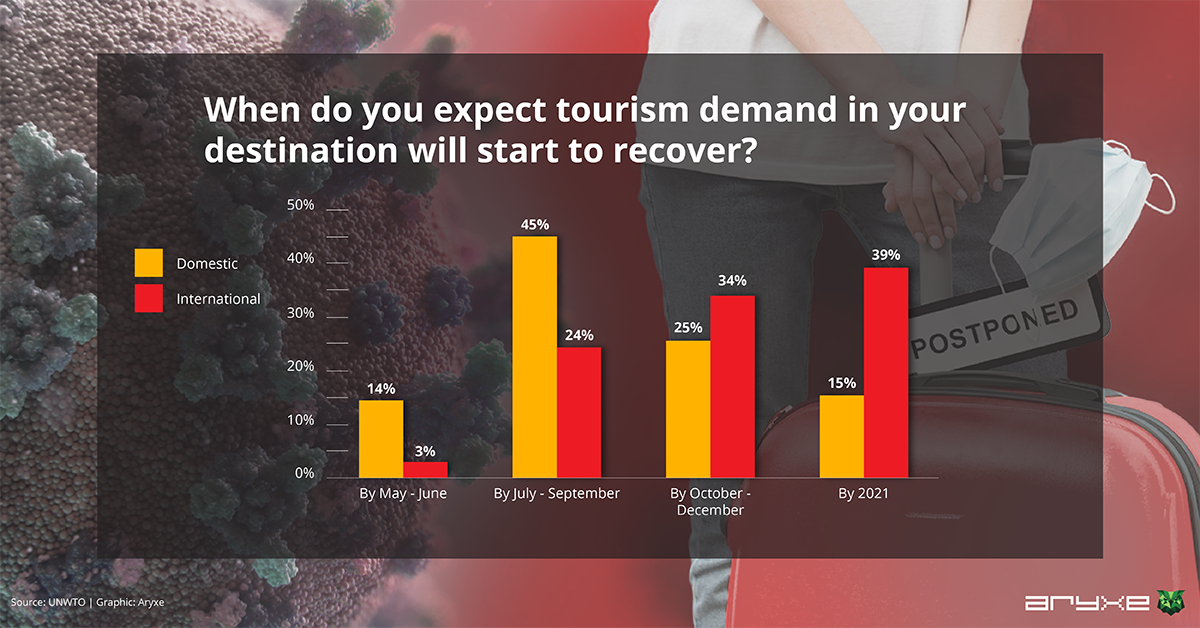
Travelling less is not an acceptable concept for the hoteliers and their staff. Not having guests means being at risk of going out of business. So the hotels are doing their best to keep on going, being mindful of their capabilities. What this translates to in the world of the workers in the labour-intensive tourism industry is having a reduced working time, facing a potential job loss and growing work challenges.
Another important detail worth mentioning is that own-account workers and micro-enterprises represent almost 60% of the accomodation and food services subsectors, which emphasizes their vulnerability to the ongoing crisis. Although they play a major role as job providers, they most frequently don’t have access to credit and they are probably not going to benefit from economic stimulus packages that governments are providing or are expected to provide.
Many hotels are closed worldwide, and many are opened and working with significantly reduced capacities. This especially applies to luxury hotels. Occupancy rates in the United States show that in early May, occupancy was less than 15% for luxury and around 40% for economy hotels.
Looking ahead, forecasts suggest that economy hotels are expected to have the fastest return to pre-pandemic levels, and luxury and upper upscale hotels to have the slowest. Among many reasons for that type of recovery dynamics is the fact that economy hotels are better able to tap segments of demand that remain relatively healthy despite travel restrictions, including truck drivers and extended-stay guests.

Essentially, businesses are struggling to retain employees and a large portion of them may not be able to access the available relief. Hence, they won’t be able to pull through this crisis. According to the US Travel Organization, travel-related job losses represent 38% of all job loss in April 2020 – which translates to more than 8 million jobs. They even added that the impact of the Covid19 outbreak is by far worse than the Great Depression and September 11.
In the year following the 9/11 events, spending on travel plunged by $57 billion, equivalent to $133 billion in economic loss. In 2020, due to the coronavirus pandemic, travel spending is expected to drop by $519 billion,which translates to $1.2 trillion in economic loss (which is 9 times more than the 9/11). In 1933, which was the worst year of the Great Depression, the unemployment rate was 25% and, this year, the overall travel industry unemployment rate is 51%.
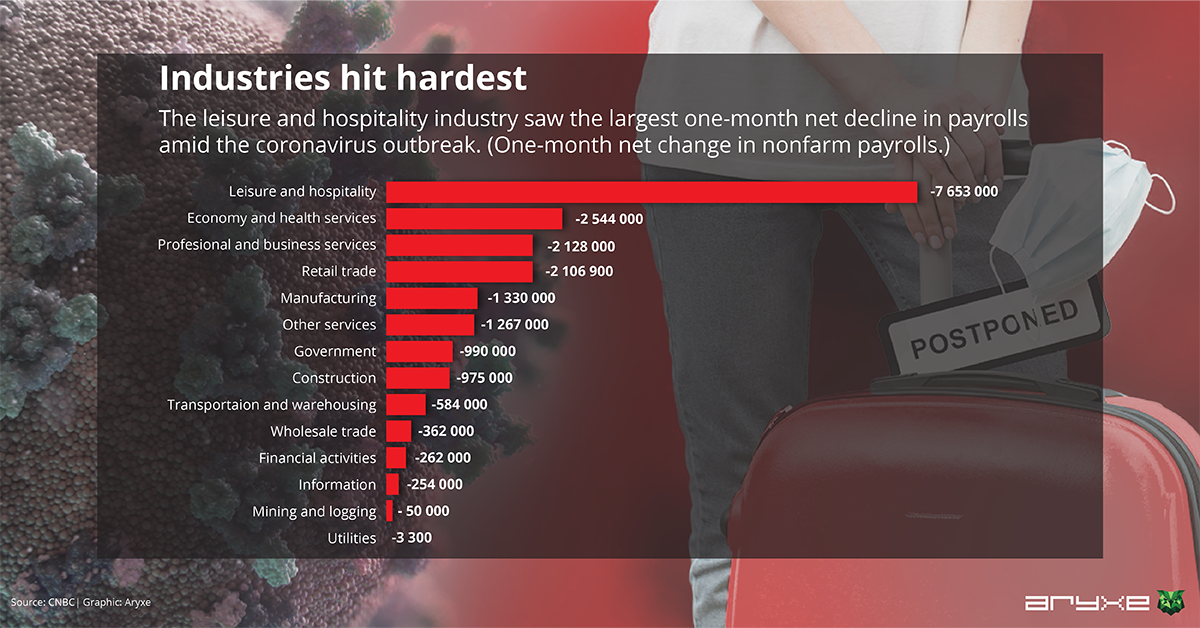
What paints the picture pretty well is Singapore. With the closure of borders to foreigners, hotels and tourist attractions are forced to rely on staycationers to fill in the gap in an industry that brought approximately $20 billion in revenue in 2019. As you may already know, this is a tall order. Also, the CEO of Accor SA’s Asia Pacific unit, the largest hotel operator in Singapore, backed that up by saying that unless there is a return of international visits, the hotel industry is going to be gutted by a loss of bookings, since international travelers make up to 90% of their bookings.
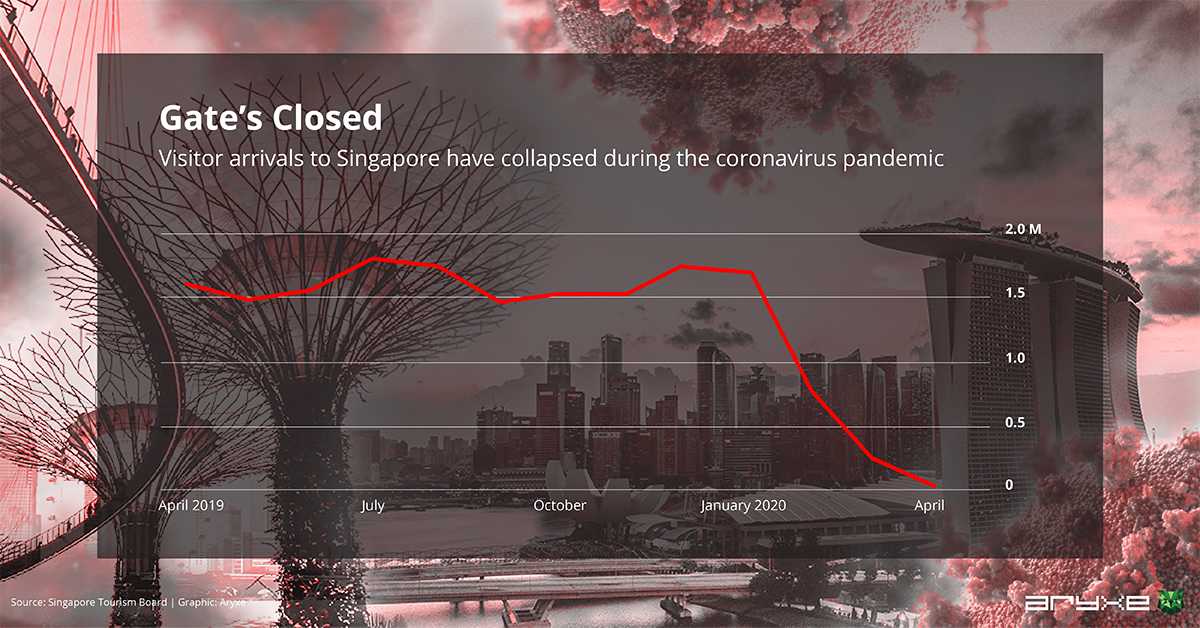
The storyline isn’t the same everywhere, so while some hotel operators are being hammered by the pandemic, the gradual opening of domestic travel has given a boost to the hotels in places like Australia and Vietnam. The CEO of Rosewood Hotel Group stated that they have seen occupancy rates as high as 70% at certain properties as leisure travel started picking up.
It looks like the main idea of survival for those in the hospitality industry right now is to refocus on drawing interest to staycations, food discounts and attractions. And, while this may work out better for the restaurants and coffee shops, hotels are having a harder time as the majority of people won’t opt for a hotel stay in a local town when given a chance to save up for the future. Consequently, a conclusion can easily be drawn to the fact that relying on domestic visitors may not be a longer-term sustainable solution.
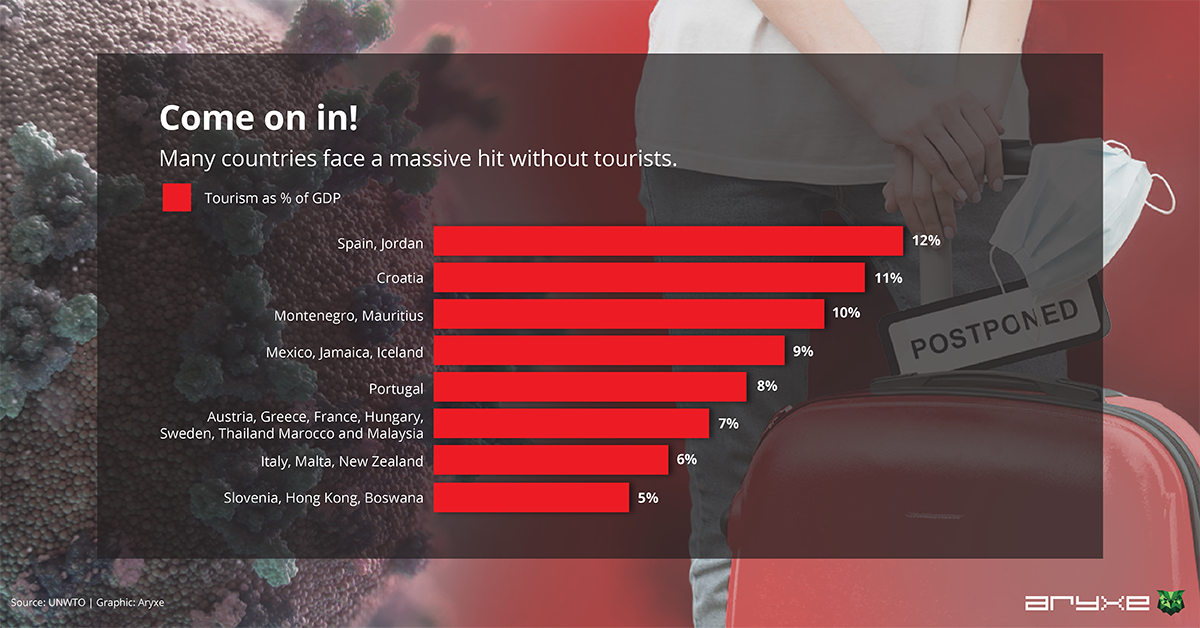
Let’s take Italy as an example. Italy was the very first European country hit by Covid19 in early spring. Italy was also one of the first to reopen its borders to EU tourists in early June. Still, tourism is suffering, with a revenue plunge predicted to top 3 billion euros.
Italian government is doing everything they can to prop up Italian tourism industry, which actually represents 13% of the national GDP. Among other strategies, they have decided to start giving financial support to households earning less than 40k euros annually as an incentive for them to go on a holiday in their own country instead of going abroad.
To paint the picture of the seriousness of the revenue shortfall in the tourism sector, here’s a visual representation of the expected impact of the pandemic on tourist arrivals in Italy, by region, in 2020.
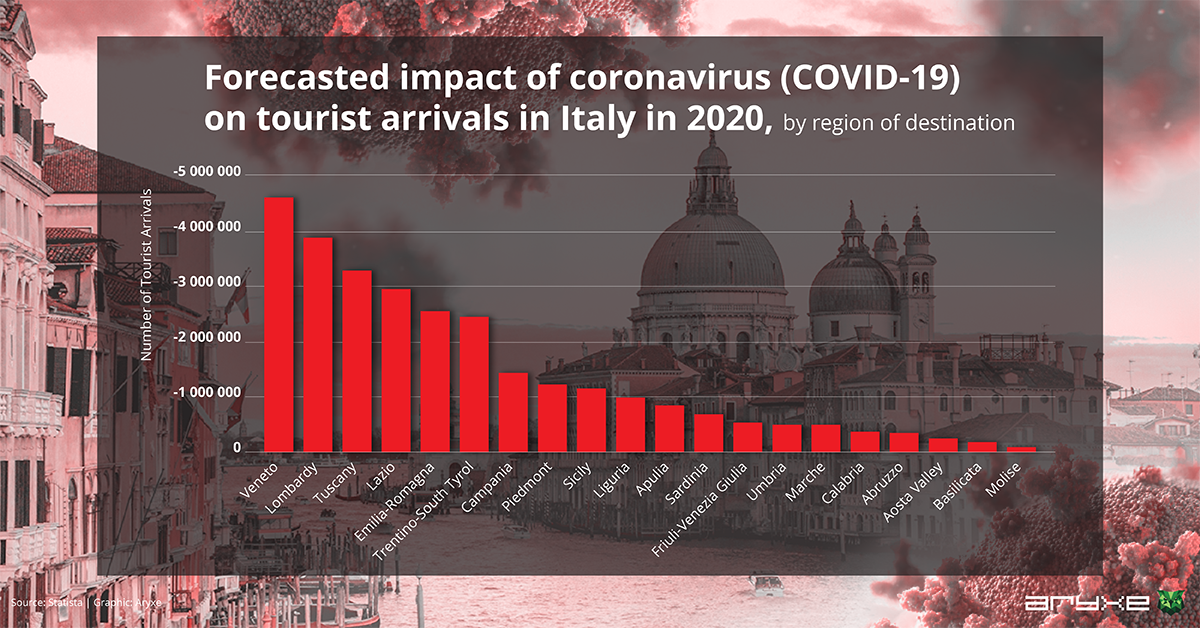
Essentially, regardless of the travel restrictions being lifted across Europe, there is a visible reluctance to travel outside of national borders. According to ENIT, Italy’s national tourism agency, airplane reservations to Italy suggest drops of 95.2% in June, 82.4% in July and 76.4% in August, when compared to the same periods in 2019.
A significantly lower number of tourists wandering Italian streets and public squares comes as a partial relief to the locals who were getting really tired by the concept of overtourism. And, at the same time, it carries a huge financial burden as Italy does rely heavily on the revenue driven by tourism. Hopefully this will be taken as a chance for Italy to come up with a plan to roll out a more sustainable tourism. Venice is a perfect example of overtourism. There are more tourists visiting the city on its busy days than there are actual Venetians living in it – which is an astonishing fact! Venice citizens have been involved in protests, trying their hardest to be vocal about the damage tourists are involved in. Gigantic cruise ships, messing with the seabed have been on the brink of a total ban in 2019, then there’s flooding and pollution – and all of these, including many more reasons, are the basis of the forecast saying that by 2030, Venice will become a city with almost no Venetians in it. So, in a way, the pandemic has had an unexpected side effect in places just like Venice. Cloudy canals have transformed into clear water. Locals don’t have to dread going outside and they can actually enjoy the beauties of their own cities. Less movement means better air and water quality, although it comes with a bitter taste when looking at the financial side of it.
In a statement released on May 27th, Marriott International provided an insight into the company’s global workforce and the impact that the pandemic had on its business. Apparently, the Covid19 crisis is having a more severe financial impact on Marriott’s business than the 2008 financial crisis and 9/11 had, combined. In order to adapt to this unprecedented event, they took numerous steps to ensure reducing cost and improving their liquidity. In addition to that, they announced prolonging furloughs and reduced weekly schedules that started back in April. The extension will go through October 2nd, 2020. Moreover, Marriott is also going to roll out a voluntary transition program in the United States for those that may want to leave the company and this same program is also being considered in other parts of the world. According to the company’s expectations, they won’t be having levels of business similar to the pre-Covid world prior to 2021, which may lead to a significant number of above-property position eliminations in 2020. However, they were not able to predict how many associates will be affected by this turn of events. In order to get an even better understanding of how devastating the effect of Covid19 is, let’s take a look at Marriott’s first quarter reports compared to the same period last year.
In the 2020 first quarter, Marriott reported operating income totaled $114 million, while in 2019 it totaled $510 million. Their reported net income totaled $31 million in 2020 Q1, and $375 million in 2019 Q1. And, when it comes to diluted earnings per share, this quarter they totaled 9 cents, while in 2019 the EPS totaled $1.09.
Hyatt has also announced terminating 1300 employees because of a historic drop in travel demand and the probable sluggish recovery. And the Nordic hotel group Maribel has filed for bankruptcy, with over one billion Norwegian kroner in debt (close to 95 million euros).
It’s no surprise this pandemic-era will leave an impact on how staying in a hotel will look like in the near future. At least until a vaccine, or an instantaneous testing for Covid19 is available, a hotel stay will most probably lose its personalized service and amenities. This means there will probably be less communal access in hotels, which leads to no buffets or minibars, no spa treatments, no bellhop or valet services. Instead, guests will probably seek for contactless or keyless check-in and out. Staying in a room that has been carefully disinfected and cleaned thoroughly.
As states and countries start to open up again, the demand is creeping up and the hotel industry now has to go the extra mile to ensure putting additional safety measures in place to protect their guests against the Covid19 transmission.
Hotel Hilton is developing policies with help from the Mayo Clinic’s Infection Prevention & Control team. In fact, they are exploring the use of electrostatic sprayers and UV light to sanitize surfaces and objects. Marriott has already announced they will use electrostatic sprayers to clean public areas and guest rooms and they are currently testing the UV light technology. In addition to these measures, hotels will also be removing and rearranging furniture to ensure the 6-foot physical distancing. Another measure that is being considered or already adopted in hotels are plexiglass barriers at front desks that are there to physically separate staff from guests.
One thing is certain, these measures will hurt the pockets of hotel owners, but whether guests will be the ones sensing the aftermath in their room rates and costs is still unclear.
We see the shift towards contactless service more as a certainty rather than a probability now. And, Marriott is the true example of this as in more than 3k Marriott hotels, guests can use their phones to check in, access their rooms and order contactless room service delivery. Another sure thing is that gloves and masks will be ubiquitous at the majority of hotels, along with hand sanitizers and disinfectant wipes as the latest additions to the amenity kits. There will probably be a limit to how many people can ride in an elevator, how many can dine in a hotel restaurant and how many can be in entertainment venues at the same time.
Another line of defense in detecting coronavirus infection is temperature screening for both guests and hotel staff. For instance, at The Venitian in Las Vegas, they will use thermal scanners at entry points to allow for discrete and noninvasive temperature checks. The Four Seasons in NY has been following an extremely strict set of protocols since it began hosting health care workers back in early April, at the very beginning of the aggressive pandemic spread. They are checking each person’s temperature and they have nurses asking questions 24 hours a day to those who enter in order to rule out a possible infection. Still, regardless of the temperature checks and all the other symptom detection measures in place, we know that there are chances of asymptomatic transmission, which means that social distancing is also necessary (if not required). The level of screening that is used in The Four Seasons is not feasible for every property.
If you’re a hotel owner, we won’t lie to you, there’s a critical period for you and your business but instead of falling into despair, here’s what you can do to tackle this crisis and stay afloat:
Playing risky isn’t the way to keep the guests coming. People want to feel safe, and rightfully so. Therefore, you should think about investing all the efforts into developing strict safety measures. If you can organize temperature screening at the entry point – great! Think about adding hand sanitizer in the common spaces and in the amenity kits. You should also give contactless checking in and out some thought. The same goes for social distancing, you should probably think about adding plexiglass at the reception and equip your staff with masks and gloves.
Hotels are used to having guests check out in the morning and then new guests check into the same room within a couple of hours. Right now, that doesn’t really seem like a way to go. You should think about developing a strategy where there’s a 24-hour time frame between the guests coming and going.
Cleanliness has always been important but at the moment it has become critical. Being known as a hotel owner offering sparkling clean, disinfected space for the guests will lead to more bookings. That being said, investing in cleaning will most probably pay out.
Finally, be vocal about the measures that you are putting in place. You’ll want your guests to learn exactly what you’re doing when it comes to hygiene, cleanliness and physical distancing. That way, when they walk through the door of your hotel, they feel safe and secure. In this new era of traveling, the notion of care will receive a whole new dimension. A lot will be based on trust. So you need to work on building safety programs based on stringent procedures in order to earn the trust of travelers and make their stay as carefree as possible.
Experts tend to agree on one thing: Travel will return. Now, the recovery is likely to take longer than in other industries, and it will be different across segments. For instance, leisure and business travel will return at a different pace. And, the same will happen with domestic and international travel. The new normal, in the post-Covid19 world, wll be marked by structural changes, especially driven by customer’s expectations related to cleanliness, flexibility and hygiene.
Companies are relying on technology as a substitute for nonessential travel. Some even go as far as saying that some types of business travel may never return to pre-Covid19 levels. In leisure, traveling to visit friends and family will most likely return first. Close-to-home and domestic travel are expected to have the quickest recovery due to shelter-in-place restrictions. Short planning cycles and extremely short booking windows are expected to become the new normal as travelers don’t want to take the risk of booking too far ahead and then facing a cancellation due to possible restrictions.
Let’s say this again – Travel will return. Maybe not as fast as we would like, maybe even not to the same levels as it were in the pre-Covid19 world but it will most definitely return. The ones who are staying flexible, caring and approachable towards the consumers will be able to keep their businesses going and survive this crisis.
Resources
https://www.hospitalitynet.org/opinion/4017990.html
http://www.buildinghistory.org/buildings/inns.shtml
https://www.blog.bidroom.com/brief-history-hotels/
https://hospitalityinsights.ehl.edu/origins-hospitality-industry
https://www.soegjobs.com/hospitality-industry-historical-background/
https://www.hospitalitynet.org/news/4098377.html
https://www.emarketer.com/content/travel-times-of-covid-19
https://www.travelandleisure.com/hotels-resorts/hotels-responding-to-coronavirus
https://www.barrons.com/articles/coronavirus-rocks-the-luxury-hotel-industry-01585225531
https://www.bbc.com/news/education-53064512
https://edition.cnn.com/2020/06/16/business/hilton-layoffs-coronavirus/index.html
https://edition.cnn.com/travel/article/hotel-health-partnerships-coronavirus/index.html
https://edition.cnn.com/travel/article/hotels-safety-coronavirus/index.html
https://www.hotelmanagement.net/operate/marriott-outlines-covid-19-s-unprecedented-q1-effects
https://norwaytoday.info/finance/the-hotel-group-maribel-is-bankrupt/
https://www.unwto.org/news/covid-19-international-tourist-numbers-could-fall-60-80-in-2020
https://www.businessinsider.com/are-hotels-safe-coronavirus
https://www.businessinsider.com/are-hotels-safe-coronavirus#what-are-hotels-doing-to-mitigate-risk
https://edition.cnn.com/travel/article/hotels-safety-coronavirus/index.html
https://www.healthline.com/health-news/covid-19-hotels-airbnb-safety